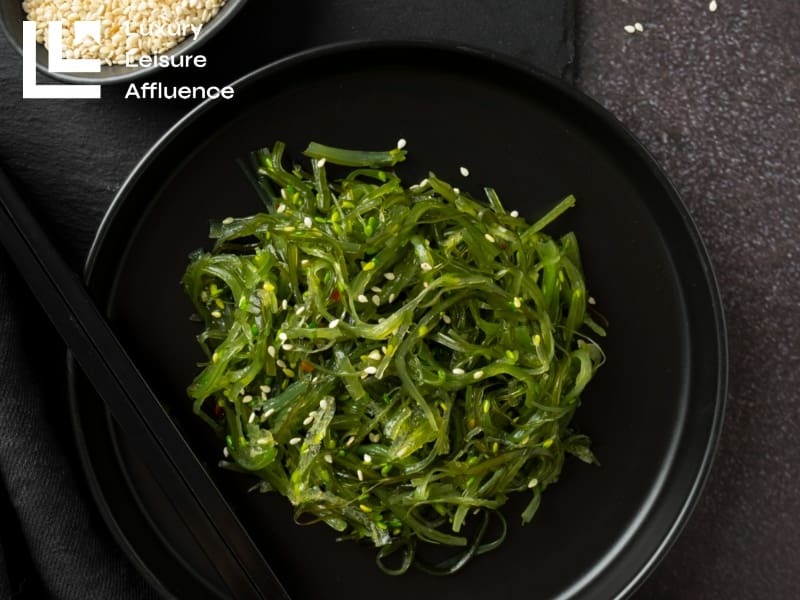Updated On: April 07, 2024 by Nouran Ashraf
Move over kale, quinoa, and your trendy superfood friends! There’s a new sheriff in town, and she’s clad in emerald green, ruffled by the tide, and packed with umami punch. Yes, folks, we’re talking about seaweed, the ocean’s hidden gem that’s about to rock your culinary world.
Forget your boring landlubber lettuce; we’re talking about the real MVPs of the marine world, the seaweed superstars that’ll rock your taste buds and turn your kitchen into an aquatic wonderland. So buckle up because we’re about to unleash the “7 Best Seaweed in the World.”
Prepare to be wowed by the versatility of these seaweed gems, which can transform your salads, soups, snacks, and even desserts into culinary masterpieces.
7 Best Seaweed in the World

Now that you’ve dipped your toes into the bright world of seaweed, there’s no turning back. Dive deeper, try new things, and let these sea treasures boost your meals.
Remember, the ocean is enormous, and there’s a kelp’s worth of seaweed flavours just waiting to be explored. Let’s find out more about the best seaweed in the world.
Nori (Japan)
Nori is a fantastic seaweed with a rich history and diverse uses! Here’s a deeper dive into its details:
What is Nori?
- Nori is edible seaweed made from red algae species, primarily Pyropia yezoensis and Pyropia tenera.
- It’s cultivated in cold, shallow waters, primarily around Japan and Korea.
- Nori is traditionally processed by shredding the algae, forming it into thin sheets, and drying them in the sun or under controlled temperature.
Taste and Texture
- Nori has a unique “umami” flavour, described as savoury, seaweed-like, and slightly sweet.
- Roasting enhances the savoury notes and gives it a satisfying, crispy texture.
- Its thinness makes it flexible and perfect for wrapping and garnishing.
Uses in Cooking
- Nori is commonly used in sushi rolls and onigiri (rice balls).
- It adds a delicious savoury layer and helps hold the ingredients together.
- Shredded or crumbled nori can be sprinkled on soups, salads, noodles, and rice bowls for a flavour boost and extra nutrients.
- Roasted nori sheets can be enjoyed as a healthy and satisfying snack on their own.
Nutritional Value
- Nori is a nutritional powerhouse, rich in:
- Vitamins: A, B12, C, E
- Minerals: Iron, iodine, calcium, magnesium
- Fibre
- Protein
- Antioxidants
Types of Nori
- Gold grade: Highest quality, deep green colour, strong flavour and aroma.
- Green grade: Good quality, slightly lighter green colour, milder flavour.
- Red grade: Lower quality, reddish tint, used for snacks or flavouring.
Tips for Storing and Using Nori
- Store nori in a cool, dry place with a desiccant (absorbs moisture) to prevent it from becoming rigid or spoiling.
- Once opened, reseal the package tightly to avoid exposure to air and moisture.
- Toast nori briefly over low heat for a few seconds to enhance its flavour and texture.
Exploring Nori Beyond Sushi
- Use nori sheets to wrap sandwiches, crackers, or cheese slices for a healthy, portable snack.
- Crumble nori over popcorn or homemade potato chips for a savoury topping.
- Add it to dips and hummus for a umami punch.
- Blend it into smoothies for a nutrient boost and unique flavour.
Kombu (Japan/Korea)
Kombu! Another champion of the seaweed world. Here’s a closer look at this umami-rich kelp.
What is Kombu?
- Kombu is a type of kelp, a large brown seaweed belonging to the Laminariaceae family.
- It’s grown in cold, nutrient-rich waters around Japan and Korea.
- Kombu is harvested, dried, and sometimes further processed into flakes or knots.
Taste and Texture
- Kombu has a deep, savoury flavour, often described as umami-rich, earthy, and slightly sweet.
- It’s relatively rigid and not meant to be eaten directly but instead used for infusing flavour and nutrients into broths and stews.
- The texture softens during cooking but still retains a slight chew.
Uses in Cooking
- Kombu is the star ingredient in dashi, the essential Japanese soup stock used in countless dishes.
- It adds umami depth to soups, stews, braises, and sauces.
- A small piece of kombu can be used to wrap tofu or vegetables, infusing them with their subtle flavour.
- Kombu flakes can be sprinkled on finished dishes for a salty, umami boost.
Nutritional Value
- Kombu is a nutritional powerhouse, just like nori, rich in:
- Minerals: Iodine, calcium, magnesium, potassium
- Vitamins: B12, E
- Glutamic acid: The amino acid responsible for umami flavour
- Fibre
Types of Kombu
- Ma-kombu: The most common type, thick and flat, with a strong flavour and aroma.
- Hoshi-kombu: Grated and dried kombu, convenient for adding flavour quickly.
- Tororo-kombu: Shaved and dried kombu, adding a silky texture and umami to broths.
Tips for Storing and Using Kombu
- Store the kombu in a cool, dry place away from direct sunlight.
- Wipe it with a damp cloth before using it to remove any surface dust.
- A small piece of kombu can be reused several times for making dashi.
- Don’t boil kombu for too long, as it can become bitter.
Kombu Beyond Dashi
- Experiment with kombu in non-traditional dishes. Add it to vegetable roasts, pasta sauces, or even bean burgers for a savoury kick.
- Use kombu flakes as a healthy alternative to salt on popcorn, chips, or salads.
- Infuse kombu in hot water to make a quick and flavorful seaweed tea.
Hijiki (Japan/Korea)
Hijiki, a versatile and nutritious seaweed native to Japan and Korea, packs a delightful punch of umami flavour and crunchy texture. Let’s dive deeper into this unique ingredient:
What is Hijiki?
Hijiki is a brown seaweed belonging to the Hizikia family. It grows primarily in cold, shallow waters along the rocky coasts of Japan and Korea.
Traditionally hand-harvested, hijiki undergoes meticulous drying and processing before reaching your kitchen.
Taste and Texture
Hijiki boasts a distinctly earthy, slightly sweet flavour with a touch of nuttiness. Its texture is pleasantly chewy, adding a contrasting element to various dishes.
Nutritional Value
Hijiki is a nutritional powerhouse, brimming with:
- Minerals: Iron, calcium, iodine, magnesium
- Vitamins: B vitamins, vitamin C
- Fibre
- Antioxidants
Cooking with Hijiki
Soak dried hijiki in water for about 20 minutes until rehydrated. Then, rinse thoroughly to remove any sand or impurities. Hijiki shines in various culinary creations:
- Salads: Add rehydrated hijiki to salads for a burst of umami and a satisfying crunch. It pairs well with cucumbers, carrots, and sesame seeds.
- Soups and stews: Hijiki lends depth and complexity to broths and stews. Add it to miso soup, vegetable stews, or even lentil curries.
- Stir-fries: Hijiki’s chewy texture and rich flavour make it a fantastic addition to stir-fries. Combine it with tofu, vegetables, and your favourite stir-fry sauce.
- Rice dishes: Elevate your rice bowls with a sprinkle of rehydrated hijiki. It pairs well with brown rice, quinoa, or even sushi rice.
Tips for Cooking with Hijiki
- Don’t overcook hijiki, as it can become challenging. Aim for a tender yet slightly chewy texture.
- Rinse hijiki thoroughly before using it to remove any sand or impurities.
- To enhance its flavour, toast hijiki lightly in a dry pan before adding it to your dish.
- Be mindful of hijiki’s high iodine content. If you have thyroid concerns, consult your doctor before consuming hijiki regularly.
Exploring Hijiki Beyond Traditional Uses
Hijiki’s versatility extends beyond traditional Japanese and Korean cuisine. Feel free to experiment:
- Use hijiki as a topping for avocado toast or scrambled eggs for a unique umami twist.
- Add it to homemade granola bars or energy bites to boost nutrients and texture.
- Grind hijiki into a powder and sprinkle it on popcorn or roasted vegetables for a savoury seasoning.
Wakame (Japan/Korea)
This emerald gem of the seaweed world brings a delightful combination of salty sweetness, crunchy texture, and impressive nutritional value to your plate. Let’s explore the wonderful world of wakame:
What is Wakame?
Wakame (Undaria pinnatifida) is a kelp native to the cold, temperate coasts of the northwest Pacific Ocean, particularly in Japan and Korea.
It’s often farmed in aquaculture, ensuring a sustainable and readily available supply.
Taste and Texture
Wakame boasts a subtly sweet, slightly salty flavour with a distinct seaweed undertone. It’s known for its tender, crunchy texture, adding a refreshing dimension to dishes.
Nutritional Value
Wakame packs a nutritional punch, rich in:
- Vitamins: A, B vitamins, C
- Minerals: Iodine, calcium, magnesium, iron
- Fibre
- Antioxidants
Cooking with Wakame
- Soups and salads: Wakame is a star ingredient in miso soup, adding a refreshing crunch and delicate flavour. It also thrives in cold soba or seaweed salads, often dressed with sesame oil and vinegar.
- Noodles and stir-fries: Wakame elevates noodle dishes like ramen or udon and adds a delightful texture to stir-fries.
- Tofu dishes: Pair wakame with tofu in salads, stir-fries, or even miso soup for a satisfying and nutrient-rich combination.
- Snacks: Savor wakame as a healthy snack on its own, roasted briefly with a drizzle of soy sauce and sesame seeds.
Tips for Cooking with Wakame
- Remember, wakame expands significantly when rehydrated. Adjust your amounts accordingly.
- For dried wakame, soak it in water for 10-15 minutes before use. Rinse thoroughly afterwards.
- Fresh wakame requires minimal prep. Simply remove any tough stems and rinse quickly.
- Don’t overcook wakame. Aim for a crisp-tender texture to enjoy its unique bite fully.
Exploring Wakame Beyond Traditional Uses
- Add wakame to avocado toast, wraps, or sandwiches for a burst of freshness and nutrients.
- Blend it into smoothies for a subtle seaweed undertone and a boost of vitamins and minerals.
- Experiment with wakame in homemade dips and sauces for a unique flavour twist.
- Sprinkle dehydrated wakame crumbs over popcorn or roasted vegetables for a flavorful and healthy topping.
Dulse (North Atlantic)
This vibrant red seaweed packs a punch of salty-umami flavour and a surprisingly versatile texture, making it a delightful addition to various dishes. Let’s dive into the fascinating world of dulse:
What is Dulse?
Dulse (Palmaria palmata) is a red seaweed common along the rocky shores of the North Atlantic and Pacific Oceans.
It thrives in cold, nutrient-rich waters and is often hand-harvested, ensuring sustainable practice. Dulse comes in various shades of red, from deep crimson to a delicate pink, adding visual appeal to your plate.
Taste and Texture
Dulse boasts a unique flavour profile. Imagine a rich, salty umami base with hints of bacon, smoke, and a touch of sweetness. Its texture is surprisingly varied, ranging from soft and chewy to crisp and flaky, depending on how it’s prepared. This versatility makes it a fun ingredient to experiment with.
Nutritional Value
- Vitamins: A, B vitamins, C
- Minerals: Iodine, potassium, iron, magnesium
- Fibre
- Antioxidants
Cooking with Dulse
- Snacks: Enjoy dulse on its own as a healthy and flavorful snack. Dried dulse flakes offer a satisfying crunch, while toasted sheets provide a satisfyingly chewy treat.
- Salads and soups: Sprinkle dulse flakes over salads for a salty-umami kick, or add them to soups for a depth of flavour.
- Eggs and scrambles: Enhance your morning scramble with crumbled dulse, adding a smoky dimension and extra nutrients.
- Sauces and dips: Infuse sauces and dips with dulse flakes for a unique umami twist. Try it in pesto, hummus, or even your favourite salad dressing.
- Seafood dishes: Pair dulse with fish and shellfish for a natural flavour pairing. Sprinkle it over grilled fish or incorporate it into seafood chowders.
Tips for Cooking with Dulse
- Start with small amounts of dulse, as its flavour can be intense.
- Experiment with different textures! Dried flakes offer a different experience than toasted sheets.
- Toasting dulse intensifies its savoury flavour and adds a satisfying crunch.
- Remember, dulse adds its own saltiness, so adjust the seasoning accordingly.
Exploring Dulse Beyond Traditional Uses
- Wrap crumbled dulse in melon slices for a sweet-salty treat.
- Blend dulse flakes into dips and spreads for a unique umami punch.
- Sprinkle them over popcorn or roasted vegetables for a healthy and flavorful topping.
- Infuse hot water with dulse flakes for a nutrient-rich seaweed tea.
Irish Moss (North Atlantic)
Irish Moss, also known as Carrageenan Moss, is a fascinating seaweed native to the cold Atlantic coasts of Europe and North America.
Its unique properties and versatility make it a valuable asset in both the culinary and health worlds. Let’s explore this aquatic gem!
What is Irish Moss?
Irish Moss (Chondrus crispus) is a type of red seaweed with a distinctive purple-red or brown colour. It grows on rocky shores and thrives in the nutrient-rich, turbulent waters of the Atlantic.
Traditionally hand-harvested, Irish Moss undergoes a gentle drying process before reaching your kitchen.
Taste and Texture
Irish Moss boasts a mild, slightly sweet flavour with a hint of sea air. Its texture is notably slimy when raw but transforms into a smooth, gel-like consistency when cooked or soaked. This unique property makes it a valuable thickening agent in various dishes.
Nutritional Value
- Minerals: Iodine, potassium, calcium, magnesium
- Fibre
- Carrageenan: A naturally occurring polysaccharide with thickening and gelling properties.
Cooking with Irish Moss
- Soups and Stews: Use Irish Moss powder or flakes to naturally thicken your favourite soups and stews, adding a subtle sweetness and smooth texture.
- Puddings and Desserts: Irish Moss’s gel-forming properties make it a fantastic vegan alternative to gelatin in custards, puddings, and even jellies.
- Beverages: Add a dash of Irish Moss powder to smoothies or plant-based milk for a subtle thickener and extra nutrients.
- Baked Goods: Experiment using Irish Moss powder in bread dough or baked goods for a unique textural element and potential health benefits.
Tips for Cooking with Irish Moss
- Remember, Irish Moss’s thickening power is potent. Start with a small amount and adjust as needed.
- Soak Irish Moss flakes for at least 30 minutes before using them to soften them and release their thickening power.
- Irish Moss powder offers faster thickening but can have a slightly stronger flavour.
- Experiment with different textures! Irish Moss flakes provide a subtle crunch, while powder creates a smooth consistency.
Exploring Irish Moss Beyond the Kitchen
- Natural thickener in cosmetics: Explore using Irish Moss in homemade lotions, face masks, or hair gels for a natural thickening agent.
- Herbal remedy: Traditional herbalists use Irish Moss for its soothing and anti-inflammatory properties. However, consult a healthcare professional before using it for medicinal purposes.
Sea Spaghetti (Mediterranean)
Sea Spaghetti, with its precise name and appealing resemblance to its terrestrial counterpart, is a gorgeous seaweed with a surprisingly robust flavour and diverse uses in cooking. Let’s dive into the world of this unique oceanic vegetable!
What is Sea Spaghetti?
Sea Spaghetti (Himanthalia elongate) is a brown seaweed primarily found in the cold, nutrient-rich waters of the northeast Atlantic Ocean and the North Sea. It often grows attached to rocks near the shoreline, reaching impressive lengths of up to 2 meters. When harvested, its long, stringy fronds resemble spaghetti strands, hence the name!
Taste and Texture
Sea Spaghetti boasts a distinct flavour profile. Imagine a rich, briny-umami base with hints of earthiness and shellfish. Its texture is pleasantly chewy when cooked, providing a satisfying bite in various dishes.
Nutritional Value
- Vitamins: A, B vitamins, C
- Minerals: Iodine, calcium, magnesium, iron
- Fibre
- Antioxidants
Cooking with Sea Spaghetti
- Salads: Rehydrated Sea Spaghetti adds a delightful crunch and umami depth to salads. Marinate it in vinaigrettes or simply dress it with lemon juice and olive oil.
- Soups and stews: Use sea spaghetti as a thickener and flavour enhancer in soups and stews. Its stringy texture also provides an interesting and satisfying element.
- Stir-fries: Add rehydrated Sea Spaghetti to stir-fries for a unique texture and additional umami boost. Combine it with tofu, vegetables, and your favourite stir-fry sauce.
- Pasta dishes: Mix cooked Sea Spaghetti with your favourite pasta dishes for a salty twist. It pairs well with tomato sauces, creamy sauces, and pesto.
Tips for Cooking with Sea Spaghetti
- Dry Sea Spaghetti requires rehydration. Soak it in cold water for about 30 minutes until softened.
- Rinse thoroughly after soaking to remove any sand or impurities.
- Cook Sea Spaghetti briefly in boiling water for about 5-10 minutes. Don’t overcook, as it can become tricky.
- Experiment with flavour! Marinate Sea Spaghetti in different sauces or dressings to add another layer of dimension.
Exploring Sea Spaghetti Beyond Traditional Uses:
- Use it as a vegan bacon substitute in sandwiches or wraps for a smoky-umami flavour.
- For a salty-umami topping, chop it finely and sprinkle it over popcorn or roasted vegetables.
- Blend it into dips and spreads for a unique umami punch and textural element.
- Infuse hot water with Sea Spaghetti for a nutrient-rich seaweed tea with a salty twist.
Finally, From Sea Urchin Snacks to Dulse Dreams
Seaweed may be the most underrated wonder of the ocean. It’s delicious, nutritious, versatile, and sustainable. Now that you’ve unlocked its secrets spread the seaweed gospel! Remember, a world with more seaweed is tastier, healthier, and greener.











